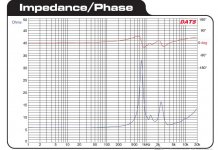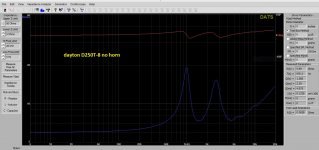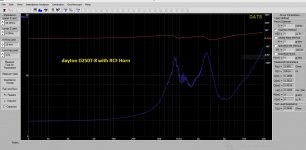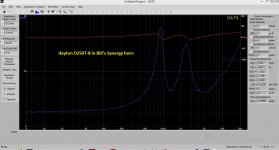Hello,
just got DATS V3 doing some measurements to design the crossover, need recommend for crossover point, slope filter...etc. Am going for 2 or 3 ways with a RCF HF96 horn. Could not find the recommendation in the spec sheet.
Dayton Audio D250T-8 1" Titanium Compression Horn Driver
Thanks,
just got DATS V3 doing some measurements to design the crossover, need recommend for crossover point, slope filter...etc. Am going for 2 or 3 ways with a RCF HF96 horn. Could not find the recommendation in the spec sheet.
Dayton Audio D250T-8 1" Titanium Compression Horn Driver
Thanks,
Attachments
To design a crossover as a starting point.
You need the impedance sweep of the drivers in the cabinet.
You also need the frequency sweeps of the drivers in the cabinet.
You need the impedance sweep of the drivers in the cabinet.
You also need the frequency sweeps of the drivers in the cabinet.
Agree, for the final product.
But could I just start design X-over base on manufacturer data?
So I need to build the box first? And with all the drivers install? Then measure for the Z and SPL?
I am question why the min X-over point not in specification.
Other manufacturers does has those like B&C, Failtalpro
But could I just start design X-over base on manufacturer data?
So I need to build the box first? And with all the drivers install? Then measure for the Z and SPL?
I am question why the min X-over point not in specification.
Other manufacturers does has those like B&C, Failtalpro
1)To design a proper passive crossover, the impedance response of a specific driver on the specific horn chosen must be determined.1)But could I just start design X-over base on manufacturer data?
2)So I need to build the box first? And with all the drivers install? Then measure for the Z and SPL?
3)I am question why the min X-over point not in specification.
Other manufacturers does has those like B&C, Failtalpro
The manufacturer data will not include the impedance response of every possible driver on it's horn, nor will the impedance response of a specific driver be the same on another horn.
2)And also the polar response of the various drivers, if you care about how the box will sound other than on axis.
3) The "minimum crossover point" for a compression driver is dependent on both excursion and power (heat). Crossing lower, excursion can reach the point where the diaphragm hits the phase plug before the voice coil burns. The "loading" of the horn and the driver's Fs will affect the excursion curve, so the "minimum crossover point" is very dependent on the driver/horn combination.
Art
So if one want to design a proper x-over he have/need to acquire the items? I assume that it's better to sim first (with the available manufacturer data) then buy later (only if it meet the requirement)..no?
You could sim some things now, and adapt a filter after you measure that impedance. The question is what do you want to sim? I don't worry about whether it is possible to achieve a certain response with a filter I haven't designed yet, not only will it be possible but it doesn't tell me anything useful.
- Home
- Loudspeakers
- Multi-Way
- crossover point suggestion



